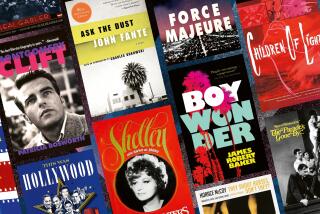Hal Ashby, turbulent genius of the ‘70s
Hal Ashby is the cinematic equivalent of a supernova. The director’s work burned startlingly bright for a brief period in the 1970s -- before his demons, including drug abuse, got the better of him, extinguishing his star shortly before his death in 1988.
Now, the director of such seminal films as “The Last Detail,” “Shampoo,” “Coming Home” and “Being There” is being rediscovered in a confluence of upcoming events (not to mention the biography “Being Hal Ashby: Life of a Hollywood Rebel” by Nick Dawson, which published in March). On Thursday, the Academy of Motion Picture Arts and Sciences pays tribute with a screening of his eccentric 1971 love story, “Harold and Maude.”
Jon Voight, who won an Oscar for 1978’s “Coming Home,” will join Judd Apatow, Cameron Crowe, Seth Rogen, Oscar-winning scribe Diablo Cody and Variety editor Peter Bart at the Samuel Goldwyn Theater for a panel discussion and Yusuf Islam will perform two songs from “Harold and Maude” that he recorded as Cat Stevens. The academy will then screen Ashby’s work at the Linwood Dunn Theater beginning with “The Landlord” and “Shampoo” on Friday and continuing with other films through Sunday.
Meanwhile, in its own tribute on Monday, the UCLA Film and Television Archive at the Billy Wilder Theater will unveil the director’s cut of Ashby’s 1982 comedy-drama “Lookin’ to Get Out,” starring -- and co-written by -- Voight. The film also features the screen debut of a young Angelina Jolie, Voight’s daughter. The story of the friendship between two gamblers had been taken away from Ashby and reedited -- and then it flopped. But Ashby restored his vision of the film and donated it to the archive.
Curtis Hanson (“L.A. Confidential”) will host the event, which will feature a panel discussion with Voight, costar Ann-Margret and cinematographer Haskell Wexler. (Warner Home Video will release the DVD of “Lookin’ ” on Tuesday.)
“He was very special,” Voight recalls of Ashby, who, after having gone through recovery for a drinking problem, died of pancreatic cancer. “If you love his movies, you love Hal. You know a lot about him from his movies because he is his films -- his unique sense of humor, his love for people, his observation of it all. He didn’t have a normal take.”
His off-kilter vision is front and center in “Harold and Maude,” a quirky comedy about the love affair between a suicidal teenager (Bud Cort) and a feisty senior (Ruth Gordon). “Not a lot of people would be able to handle it with the light touch he has,” says academy programmer Ellen Harrington. “It’s this kind of life-affirming connection that finds beauty in tragedy and dark humor.”
His range as a filmmaker, Harrington says, was “amazing, whether he’s looking at the superficial world of Beverly Hills’ hairdressers and their sexual high jinks in ‘Shampoo’ or the really serious emotional dysfunction among Vietnam War vets and the tragedy that war visited on people who survived it in ‘Coming Home.’ He is really turning his lens quite specifically on American society.”
“I didn’t know Hal Ashby,” Hanson says, “but one feels watching the movies that they are colored by his own optimism and his own open-hearted love of the characters. His films perfectly expressed the spirit that was in this country in the late ‘60s and ‘70s more than any other filmmaking I can think of.”
Ashby also had a deft touch with actors. Four of his performers received Oscars for their work -- Lee Grant for “Shampoo,” Voight and Jane Fonda for “Coming Home” and Melvyn Douglas for 1979’s “Being There.” Six more were nominated. (Ashby, a former film editor, won his only Oscar for cutting 1967’s “In the Heat of the Night.”)
“I compare him right now today to Phil Jackson of the Lakers, in that he enjoyed the players, but he didn’t interfere,” Voight says. “It was a tremendously freeing atmosphere and, in a sense, you couldn’t believe you were being allowed that freedom of expression.”
Crowe cites Ashby’s use of music, whether it be the Cat Stevens songs or the ballads of Woody Guthrie in his 1976 biopic on the troubadour “Bound for Glory.” Two years ago, his company released the restored soundtrack for “Harold and Maude.” Doing the liner notes, Crowe and a colleague interviewed many who worked on the film.
“People were exploding with anecdotes and stories,” Crowe says. “It has been exciting to see the appreciation become more and more powerful where a guy like Sam Mendes makes a movie like ‘Away We Go’ and openly references Hal.”
Ashby, Crowe says, “has been an underappreciated guy, but like so many artists who were slightly ahead of their time, there is a zeitgeist moment that arrives. It feels that it’s Hal’s time.”
The “Harold and Maude” screening is sold out, but there will be a standby line. For more information on the screenings, go to www.oscars.org. For information on the “Lookin’ to Get Out” screening, go to www.cinema.ucla.edu.
--
More to Read
Only good movies
Get the Indie Focus newsletter, Mark Olsen's weekly guide to the world of cinema.
You may occasionally receive promotional content from the Los Angeles Times.











